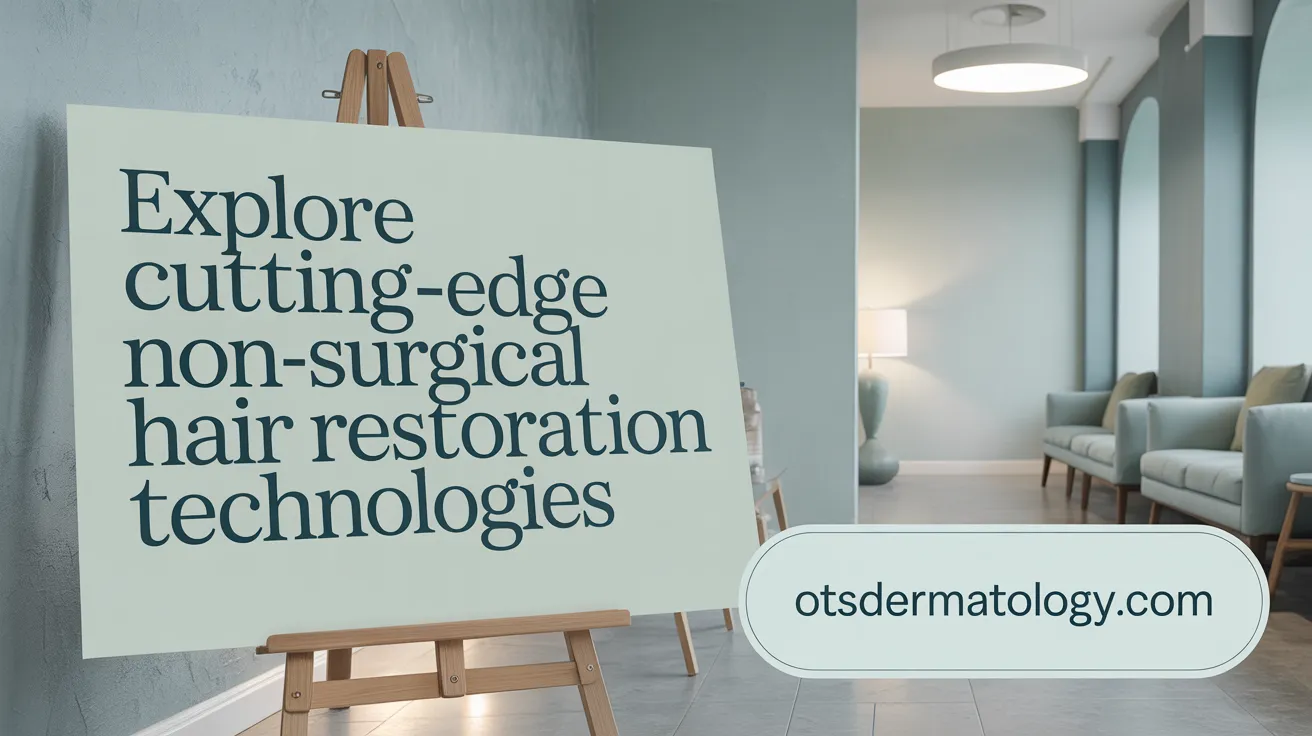The Evolution of Hair Restoration Technologies
Overview of Hair Loss Challenges
Hair loss affects millions globally, driven by genetics, hormonal changes, autoimmune diseases, and environmental factors. It can present as thinning, patchy bald spots, or extensive loss, creating significant psychological and cosmetic concerns. Early diagnosis is critical to slow progression and improve outcomes.
Growth of New Medical and Cosmetic Treatments
Recent advances have expanded treatment options beyond conventional medications and surgical transplants. Innovations include low-dose oral minoxidil, advanced laser therapies such as the FDA-approved FoLix fractional laser, and ultrasound-based interventions like Alma TED™. These modalities focus on enhancing scalp health, stimulating follicles, and reducing inflammation—identified as a primary contributor to hair loss.
Introduction to PRP and Emerging Technologies
Platelet-Rich Plasma (PRP) therapy has emerged as a promising non-surgical approach. PRP utilizes autologous blood components concentrated via centrifugation to deliver growth factors that promote follicular regeneration and angiogenesis. Treatment protocols typically involve multiple sessions spaced weeks apart, with results manifesting over months. Adjunctive therapies under investigation include exosome-based treatments and advanced energy devices, representing the frontier of regenerative hair restoration. Collectively, these innovations offer personalized, minimally invasive options tailored to diverse patient needs.
Understanding Platelet-Rich Plasma (PRP) Therapy and Its Impact

What is PRP therapy and how is it prepared for hair restoration?
Platelet-Rich Plasma (PRP) therapy is a treatment that uses a concentration of platelets derived from the patient’s own blood to stimulate hair follicle activity. Preparation involves drawing approximately 18 ml of blood, which is then centrifuged at a force of around 1,100 g for 10 minutes. This process separates the platelet-rich plasma containing essential growth factors that promote tissue regeneration and hair growth. Activation of PRP often includes adding calcium gluconate to enhance growth factor release.
How is PRP administered during hair restoration treatments?
PRP is injected directly into the affected areas of the scalp using a fine 30-gauge needle. The dosage averages about 0.1 ml per square centimeter, with injections delivered at a depth of 1.5 to 2.5 mm targeting the interfollicular space. Treatments are typically spaced 4 to 6 weeks apart, conducted over three sessions, with maintenance sessions every 3 to 6 months as needed to sustain results. This method is one of the PRP injection dosage protocols that help optimize outcomes in hair restoration.
What results and side effects can patients expect from PRP therapy?
Clinical studies demonstrate significant improvements following PRP treatments, including increased hair count, density, epidermal thickness, and hair follicle proliferation. Visible results typically emerge within 3 to 6 months, with full benefits often apparent by one year. The procedure is minimally invasive, well-tolerated, and carries a low-risk profile. Common side effects include mild soreness, transient bruising, or minor localized discomfort at injection sites. The effects can last several years but may require periodic re-treatment to maintain hair growth.
PRP therapy represents an advanced, natural approach for managing hair thinning and androgenic alopecia. Its use in clinical settings such as Glenview and Algonquin, Illinois reflects growing recognition of its efficacy and safety as part of personalized hair restoration regimens.
Emerging Technologies Complementing and Advancing Hair Restoration

What non-PRP hair restoration treatments are gaining traction?
Current advancements in hair restoration include several non-PRP therapies that show promising results. Low-dose oral minoxidil, ranging from 1.25 to 5 mg, is increasingly used to slow hair loss and promote regrowth, often alongside traditional topical applications (Low-dose oral minoxidil treatment). FDA-approved fractional laser therapy, such as the FoLix system, stimulates hair regrowth by approximately 10-15% and enhances scalp health via controlled laser energy (FDA-approved fractional laser FoLix.
Additionally, ultrasound-based devices like Alma TED™ enhance scalp circulation and nutrient delivery, improving hair follicle function without invasive procedures (Alma TED™ ultrasound hair growth treatment). Photo modulation using low-energy light therapies also contributes to follicle stimulation by reducing inflammation and encouraging cellular activity (Photo modulation with low-energy lights. Experimental treatments, including exosome therapy in hair restoration that deliver growth factors directly to follicles, are under active research but remain investigational (Exosome therapy in hair restoration). Future prospects involve hair cloning and follicle banking techniques aiming to offer regenerative solutions beyond current limits (Hair cloning research.
How do these emerging treatments integrate with PRP?
Many of these innovations are integrated with platelet-rich plasma (PRP) therapy to maximize hair restoration outcomes. Combining energy-based devices like ultrasound and fractional laser with PRP injections targets both hair follicle stimulation and inflammation reduction synergistically (Ultrasound and laser combination therapy. Such multimodal approaches enhance blood flow, promote angiogenesis, and prolong anagen phases of hair growth.
Topical and oral medications often supplement PRP sessions, offering a comprehensive strategy tailored to individual patient profiles and the severity of hair loss (PRP and minoxidil). Emphasizing anti-inflammatory protocols in hair loss alongside regenerative treatments helps address underlying causes, making maintenance therapies more effective over time (Anti-inflammatory approaches to hair loss. These advances collectively provide personalized, evidence-supported options that align with patient goals and evolving clinical evidence in non-surgical hair restoration.
Personalized Dermatologic Care and Diagnostic Advances in Hair Loss Management

How do dermatology clinics personalize hair restoration treatments?
Expert dermatology clinics, such as those in Glenview and surrounding Illinois areas, utilize advanced diagnostic technologies including AI-assisted trichoscopic analysis and scalp biopsies. This comprehensive assessment identifies the underlying causes of hair loss and gauges the degree of scalp inflammation.
With precise information on patient-specific hair follicle status and inflammatory activity, dermatologists tailor treatment plans combining options like platelet-rich plasma (PRP) therapy, topical and oral medications, low-level laser therapy, and other modalities. This personalized approach addresses individual patient needs and optimizes outcomes for hair regrowth.
Why is early diagnosis critical in hair restoration?
Early diagnosis is essential because many effective hair loss treatments, including PRP therapy for hair restoration, rely on stimulating active but weakened hair follicles. Detecting hair loss and inflammation early allows for prompt intervention, which can slow or halt hair shedding progression and enhance the chances of successful regrowth.
Delayed treatment often leads to follicle miniaturization or death, which limits the effectiveness of regenerative therapies. Thus, early evaluation and management improve long-term hair restoration results and patient satisfaction.
Tailoring treatment strategies to patient-specific factors
Recognizing the diversity in hair loss patterns and causes, dermatologists develop plans that consider age, hair loss severity, underlying conditions, and patient preferences. For example, inflammation-driven alopecia may prioritize anti-inflammatory protocols in hair loss, alongside PRP therapy for hair restoration, whereas androgenetic alopecia might incorporate low-dose oral minoxidil or laser treatments. This individualized strategy accords with best practices at centers like Northwestern Medicine and the Illinois Dermatology Institute, emphasizing precision and compassionate care.
Long-Term Outcomes and Maintenance Strategies in Hair Restoration

What is the typical treatment schedule and longevity of PRP effects?
PRP therapy for hair restoration generally involves an initial series of three treatment sessions spaced approximately 4-6 weeks apart. Following these initial treatments, maintenance injections are recommended every 3 to 6 months to sustain results. Studies and clinical experience indicate that effects from PRP treatments can last between 3 to 5 years, with some patients maintaining improvement longer when retreatment is undertaken periodically. For more details, see PRP treatment schedule and Platelet-Rich Plasma (PRP) Injections.
What should patients expect regarding hair restoration outcomes?
Patients should understand that PRP therapy promotes gradual enhancement in hair density and follicle strength, commonly resulting in a 10-20% increase in hair regrowth over a year. The procedure is most effective in slowing or halting hair loss rather than fully reversing advanced baldness. Realistic expectations are crucial, as maintenance treatments and combination approaches—such as using oral minoxidil, laser therapy, or topical medications—can support and enhance hair restoration outcomes.
Why is ongoing treatment necessary, and how do combination approaches help?
Hair loss is often a chronic condition influenced by genetics, hormones, and inflammation requiring continuous management. PRP works by stimulating follicular activity and angiogenesis but does not always address underlying causes completely. Combining PRP with medications (like finasteride or low-dose minoxidil) and adjunct therapies, including laser or ultrasound devices, creates a synergistic effect to optimize hair growth and prolong treatment benefits. For additional insight on anti-inflammatory protocols in hair loss and the use of activation of PRP with calcium gluconate, see relevant resources.
How sustainable are results, and what promising therapies may support long-term outcomes?
While current PRP therapy demonstrates durability with proper maintenance, emerging treatments are expanding options. Innovations such as exosome therapy in hair restoration, fractional laser devices, and improved energy-based modalities aim to enhance long-term hair follicle regeneration and scalp health. These advances, coupled with personalized anti-inflammatory protocols in hair loss, hold promise for sustaining and improving hair restoration results over time. For deeper information on hair cloning and follicle banking, and other regenerative methods, consult the latest research.
Future Directions: From Experimental Treatments to Regenerative Medicine
What are promising future hair restoration technologies?
Research in hair restoration is rapidly advancing with several innovative approaches on the horizon. One promising area is exosome therapy in hair restoration, where exosomes rich in growth factors and signaling molecules are delivered directly to hair follicles. These cell-derived vesicles have the potential to promote follicle regeneration and improve hair growth beyond the capabilities of current treatments. Concurrently, hair cloning and follicle banking technologies are being developed. These techniques aim to expand the limited donor hair supply by culturing and preserving hair follicle cells, offering a groundbreaking solution for patients with advanced hair loss.
How is inflammation being targeted in emerging hair loss treatments?
Emerging hair loss therapies increasingly focus on anti-inflammatory protocols in hair loss, the role of inflammation in hair follicle damage. Chronic scalp inflammation is a recognized driver of hair thinning and loss. New diagnostic tools such as scalp biopsies and AI-assisted analysis help identify inflammatory processes, enabling personalized, targeted interventions. Treatments incorporating anti-inflammatory agents seek to calm the scalp environment, reduce follicular damage, and improve treatment outcomes. This anti-inflammatory focus represents a shift toward more comprehensive hair loss management. For more clinical approaches, see the Northwestern Medicine Hair Loss Clinic.
Integration of regenerative medicine in hair loss therapy
The future of hair restoration lies in the integration of regenerative medicine, applying biologically based technologies to rejuvenate hair follicles naturally. This includes combining PRP therapy for hair growth, exosome therapy in hair restoration, and low-level laser or ultrasound treatments to enhance follicle stem cell activity and stimulate angiogenesis. Such multimodal approaches aim to restore hair density more effectively than single therapies.
Overall, combining experimental regenerative techniques with anti-inflammatory strategies holds great promise for more durable and effective hair restoration solutions, especially for patients who have exhausted traditional options.
Looking Ahead: Personalized, Effective, and Evolving Hair Restoration Options
Current and Emerging Treatments
Hair restoration now includes platelet-rich plasma (PRP) therapy, low-dose oral minoxidil, fractional lasers, and emerging energy-based devices like ultrasound. PRP utilizes patient's platelets to stimulate follicle growth naturally, often combined with medications for enhanced effects.
Tailored Care and Patient Education
Personalized treatment plans are vital, factoring individual conditions, early diagnosis, and patient expectations. Clinics emphasize educating patients on realistic outcomes and maintenance needs to optimize results.
Future Advances
Anticipated innovations include hair cloning, exosome therapies, and refined regenerative techniques aimed at improving hair density and longevity. These advancements promise to raise efficacy and patient satisfaction while expanding treatment accessibility.
